Shopping for a cheap thermal imaging camera?
You’ve come to the right place.
When thermal imaging cameras were first developed, they were anything but cheap. The units were big, bulky, hard to move around — and cost thousands and thousands of dollars.
As time passed, thermal imaging cameras became smaller, and more widely available, but still remained expensive.
The last decade has brought about even more thermal imager manufacturers, and prices have continued to fall on some of the most basic and entry-level IR cameras.
The drops in prices and improvements in technology have been good for consumers, and now a cheap thermal imaging camera is easy to acquire.
When I say “cheap,” I don’t mean cheap in quality. I literally mean cheap in price..as long as you think a couple hundred dollars is cheap.
Compared to some of the older versions of thermal imagers, and some of the top of the line ones available, that is cheap.
While these cheap thermal imagers make capturing infrared images much more attainable for the average consumer, they are in fact still of very good quality.
No, they aren’t as advanced as some of the models that run $2k+, but they are more than capable of getting the job done.
What’s In this Buying Guide?
In this buying guide, we recommend the best thermal imaging cameras that don’t cost an arm and a leg. All our top picks sell for under $500 or slightly more.
We have great recommendation for hobbyists and amateurs as well as pros looking for an affordable thermal camera for their work.
We also explain what to expect – and not to expect – whenshopping for a budget thermal cameras and how to choose the right one for your needs.
Best Cheap Thermal Imaging Cameras
Disclaimer: All links below go to Amazon.com
Seek Thermal Compact
Temperature Range
-40°F to 626°F
FLIR ONE Gen 3
Temperature Range
-4°F to 248°F
FLIR TG165
Temperature Range
–13°F to +716°F
FLIR Scout TK
Temperature Range
Not Specified
Hti HT-19
Temperature Range
-4°F to 572°F
PerfectPrime IR0005
Best pocket-size thermal imager
Temperature Range
-4°F to 572°F
Battery life:
Not specified
1. Best Cheap Smartphone Thermal Imager: Seek Thermal Compact
Smartphone thermal cameras are some of the cheapest thermal imagers you’ll find. They may not have the performance and capability of standalone handheld imagers, but they make up for it in convenience and portability.
One of the best smartphone thermal imager is the Seek Thermal Compact. It has a thermal resolution of 206 x 156, which is better than some handheld imager.
Pros
- Good resolution and wide field of view.
- Wide temperature range.
- Easy to use app.
- Long detection range.
Cons
- Low refresh rate – not suitable for observing moving objects.
- Emissivity is not adjustable.
Our Review
If you plan to use your infrared imager mostly around the house for home repairs and DIY projects, you don’t need an expensive handheld thermal camera. A cheap imager that plugs into your phone will do.
The Seek Thermal Compact is better than you’d expect from a smartphone imager of its size. For one, it has a better resolution than many handheld imagers that cost more.
The 206 x 156 thermal resolutionmeans higher quality images with good temperature detail. You’ll be able to differentiate between hot and cold areas and tell exactly where the problem is.
The higher image resolution also increases the Seek Thermal Compact’s detection range to an impressive 1,000 feet. This allows you to observe surface closeup or from a distance.
Another impressive capability of the Seek Thermal Compact is its wide temperature range. It can detect temperatures between -40F° to 626°F. You can use the camera on a wide range of surfaces from your AC to a car engine.
The Seek Thermal app provides plenty of features and options. You can select from several color palettes, select different measurement modes (High-Low, Threshold etc.) and record thermal photos and videos.
The Seek Thermal Compact is available in three options: Android USB-C, Android MicroUSB and iOS.
Note that the Seek Thermal Compact doesn’t have an internal battery. It runs of your phone’s power. But don’t worry; it won’t drain your phone battery quickly.
Issues and Limitations
While it’s great for home repairs and DIY enthusiasts, many professionals will find the Seek Thermal Compact imager limiting. It lacks advanced features such as adjustable emissivity and Span and Level control.
Hunters and outdoor enthusiasts will also have an issue with the Seek Thermal Compact’s low refresh rate. It makes observing moving targets difficult.
Seek Thermal Compact Upgrades
Seek Thermal sells two other smartphone thermal imagers that solve some of the limitations of the Seek Thermal Compact.
- Seek Thermal CompactPRO– A great choice for pros. The CompactPro offers a higher thermal resolution of 320 x 240, span/level control and adjustable emissivity.
- Seek Thermal CompactXR– A great choice for outdoors, hunting and security. The CompactXR has a 206 x 156 thermal resolution, a longer detection range of 1,800 feet and a tighter 20-degree field of view. Unfortunately, it still has a low 9Hz refresh rate.
2. Best Cheap Smartphone Thermal Imager for Home Repairs: FLIR ONE Gen 3
FLIR ONE Gen 3 is another popular option for homeowners and DIYers who prefer a smartphone thermal imaging camera.
FLIR ONE is particularly useful for home repairs thanks to its MSX image enhancement technology that overlays a visual image on a thermal image.
Pros
- MSX improves image detail.
- Great for spotting anomalies in your home.
- Adjustable connector.
- Easy to use app.
Cons
- Low resolution.
- Short battery life.
- Low refresh rate.
Our Review
The FLIR ONE Gen 3 has a lower resolution – 80 x 60 – than the Seek Thermal Compact imager,so thermal images may not be as detailed.
FLIR ONE makes up for it with a nifty feature called MSX image enhancement. The imager contains both a thermal and visual camera.
When you enable MSX in the app, the imager uses both cameras and overlays a visual image on the thermal image. This improves image detail and makes it easier to tell where an anomaly is when inspecting plumbing, insulation or some other part of your home.
The app also lets you switch palettes, engage different measurement modes, record images and videos, and select from several emissivity presets (a feature not available in the Seek Thermal Compact).
The FLIR ONE imager is available in two options: a USB-C version for Android devices and a Lightning version for iOS devices.
Both versions come with the new OneFit Adjustable Connector. You can adjust the height of the connector up or down, allowing you to plug in the imager with your phone case on. You don’t have to remove your phone case and put your phone at risk when using the FLIR ONE imager.
Issues and Limitations
The FLIR ONE Gen 3 thermal imager has a lower resolution sensor compared to the Seek Thermal Compact. This results in less crisp images, a lower temperature range (-4 °F to 248 °F) and a shorter detection range.
But since most home repairs involve close-up examination, this shouldn’t be a big problem.
One issue that may however bug you is the short battery life. Unlike the Seek Thermal Compact, FLIR ONE has an internal battery that depletes quickly.
FLIR ONE Gen 3 Upgrades
If you like FLIR ONE but would prefer a more capable smartphone thermal imager from FLIR, here are two excellent upgrades.
- FLIR ONE Pro – A great choice for pros. The FLIR ONE Pro has a higher thermal resolution of 160 x 120 pixels and a wider temperature range of -4°F to 752°F. In addition to MSX technology, FLIR ONE Pro also uses VividIR image processing to improve image quality.
- FLIR ONE PRO LT – The FLIR ONE PRO LT sits between the FLIR ONEand FLIR ONE PRO. The LT has the same temperature range and resolution as FLIR ONE, but offers the same MSX + VividIR image-improving combo as the FLIR ONE PRO. The LT also has better thermal sensitivity than the base model, meaning it can measure smaller temperature differences.
A spot thermal camera allows you to check the temperature of a specific spot and see which areas are hot or cold.
One of the cheapest thermal imager that’s good enough for amateurs as well as pros is the FLIR TG165. It has an extra-wide temperature range and a large spot size ratio that lets you take measurements from a safe distance.
Pros
- Wide temperature range.
- Safe measuring distance.
- Image recording.
- Hardy construction.
- Compact and portable.
Our Review
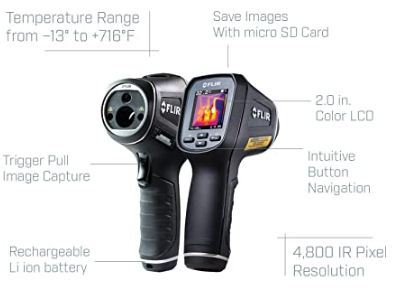
The FLIR TG165 combines a standard non-contact IR thermometer with a thermal imager, letting you measure the precise temperature of a particular spot and see a thermal image of that area.
The TG165 uses dual lasers to pinpoint the spot whose temperature you are measuring. The 2-inch LCD screen then displays a thermal image of the area around it. The wide temperature range (–13 to +716°F) allows you to measure extra-cold and extra-hot surfaces.
The control panel has an option for saving images onto the included 8GB SD card. You can later transfer the images using a USB cable or by removing the SD card.
The gun-shaped design of the TG165 makes it easy to hold and aim it where you want.
More importantly, you don’t need to get too close to target object. The TG165 has a 24:1. That means you can measure a 1-inch wide spot from up to 24 inches away, or a 1-foot area from up to 24 feet away.
The high spot size ratio allows you to stand a safe distance away when examining hazardous surfaces such as a hot car engine, high-voltage circuits or moving machinery.
For pros constantly on the move, the TG165’s compact and highly portable design is a big plus. It also includes a tripod mount for a hands-free operation. And don’t worry about some rough handling; the TG165 can withstand a 2m drop.
Issues and Limitations
The biggest limitation of the FLIR TG165 is the thermal resolution. At 80 x 60 pixels, the TG165 struggles to show a clear thermal image especially from a distance.
We recommend the TG165 for amateurs and professionals who mostly want the temperature-measurement feature. The thermal image is a nice bonus.
But if your primary need is taking detailed thermal images, we recommend a pocket-size or smartphone thermal imager with a higher resolution.
For outdoor applications like hunting, night hiking and home security, a thermal monocular or a pair of thermal binoculars is better than a smartphone or handheld thermal camera.
Thermal imaging binoculars are expensive, for now. The FLIR Scout TK thermal imaging monocular is a cheaper alternative.
The Scout TK has a high-resolution sensor that allows you to spot people and animals from 100-200 yards away.
Pros
- One of the cheapest thermal monoculars in the market.
- Good resolution and detection range.
- Lightweight, compact and easily portable.
- Image and video recording.
Cons
- Low refresh rate.
- Not suitable for long distance hunting.
Our Review
The FLIR Scout TK monocular is rugged, lightweight and compact – perfect for your outdoor adventures. A simple 4-button layout allows easy one-handed operation. And when you are done, the TK fits effortlessly in your pocket or backpack.
More important are the TK’s optics, starting with the resolution.
The thermal sensor has a resolution of 160 x 120 pixels, which is pretty good at this price point. Thermal images are clear and detailed. You can clearly make out a human or human-size animal from about 100 yards out. If you are hunting larger game, detection range increases to about 200 yards.
The 640X480 LCD display is bright and vivid, making it easier to spot targets.
With the Scout TK, you can do more than just look at animals. You can switch palettes to get a better image quality in different environments. You can also record images and videoand download them using a USB cable.
Issues and Limitations
The FLIR Scout TK is a basic hunting monocular. For serious hunting, you’ll have to spend much more on an advanced monocular or binoculars with better resolution, a detection range of more than 1,000 yards and built-in smart features such as a range finder and ballistic calculator.
If you have several thousand dollars to spare, the ATN OTS-HD 640 smart thermal monocular is an excellent choice.
Another limitation of the Scout TK is the low refresh rate. Good hunting thermal imagers have a 25Hz to 60Hz refresh rate to make it easy to track moving targets, or track an animal while you are walking.
The Scout TK has a 9Hz refresh rate. It’s okay for observing a still or slow moving target, but once the deer starts running, you’ll have trouble tracking it because of image lagging.
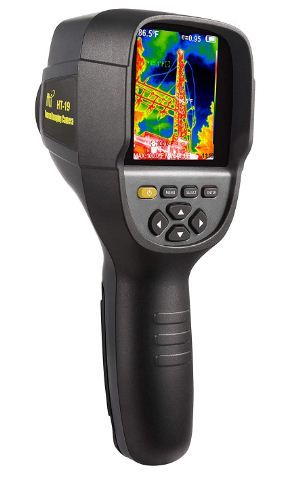
The Hti HT-19 is the cheapest thermal imaging camera we found that meets the basic needs of professionals.
It has good thermal resolution, various adjustable settings (including emissivity), and a wide temperature range.
For pros who don’t want to spend thousands of dollars on an advanced thermal camera, the HT-19 is a great bargain.
Pros
- Good value for money.
- Good thermal resolution.
- Visual and thermal image merging.
- Image capture.
- Compact & lightweight + it comes with a travel pouch.
Cons
- No video capture.Slow refresh rate.
Our Review
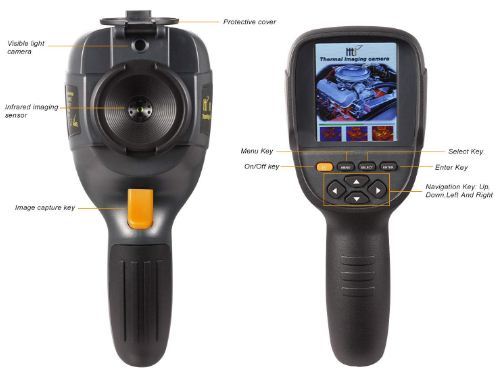
A standard professional thermal imaging camera starts at around $700 and can easily go into the thousands.
So getting the HT-19 at this price point is a great bargain. You do have to give up some perks (check the HT-19’s limitations below), but on the important feature, the HT-19 delivers.
Let’s start with the 320 x 240 resolution. It’s similar to that of many pro cameras that cost more. You get great image quality with clear distinction between different temperatures.
The HT-19 has another trick to improve image quality and detail. It has two cameras: a thermal camera and a visual camera. It merges the thermal and visual images, making it easier for you to tell exactly where an anomaly is.
You can select a visual-only mode with the temperature of various points indicated, or a thermal-only mode. When merging the two, you can choose the degree of fusion (0%, 25% 50%, 75% or 100%).
Buttons below the screen give you access to various settings including emissivity presets, palette selection, screen brightness and temperature unit.
You can also capture images and save them to the included 3GB SD card. Use a USB cable to download the images onto a computer.
For pros on the go, the HT-19 is compact and lightweight. It weighs just 13.3 ounces and comes with a storage/travel pouch.
Issues and Limitations
It is surprising the HT-19 lacks video recording, a feature common even in cheaper thermal cameras.You can only capture images.
Another issue you have to contend with is the slow refresh rate of 9Hz. You’ll notice some lagging when you move the camera over a surface or attempt to observe a moving target such as part of a machine.
Pocket-size thermal imaging cameras are great for those who want a compact and light thermal camera that’s capable.
The IR0005 packs a 35,200-pixel resolution, two cameras, a wide temperature range and a large display screen in a surprisingly small – and affordable – package.
Pros
- Small, light and portable – also comes with a travel case.
- Decent thermal resolution.
- Thermal and visual image overlay.
- Image capture.
- Adjustable emissivity.
Cons
- No video capture.
- Low refresh rate.
Our Review
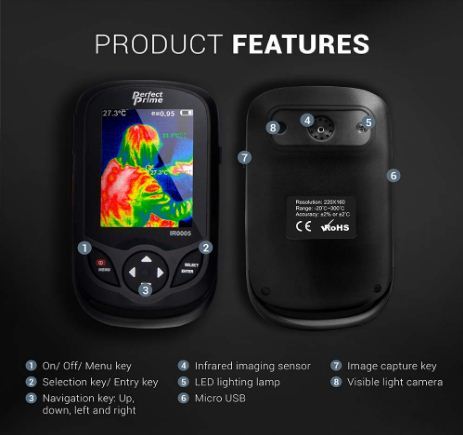
The IR0005 is compact enough to fit in your pocket. With the included hard carry case, it’s easy to carry it around with you.
The PerfectPrime IR0005 imager is a great choice for home repairs and DIY enthusiasts. The 220 x 160 thermal resolution produces clear, sharp and detailed thermal images. There’s no noise, fuzziness or pixelation that you get with many 80 x 60 imagers.
It’s easy to inspect your home insulation, plumbing, electrical appliances and even a hot car engine. The IR0005’s wide temperature range (-4°F to 572°F) makes it a versatile tool.
Similar to the HT-19 imager, the IR0005 has two cameras, so you can overlay a visual and thermal image. You can adjust how much the two images fuse.
The image overlay is handy for identifying which areas are displaying anomalies. For instance, a visual overlay of a part of the wall on a thermal image makes it easier to pinpoint exactly where there’s an air leak.
Settings include palette selections and emissivity presets. The IR0005 imager can also capture images and save them in the included 3GB SD card. A USB port on the imager lets you download the images to a computer.
Issues and Limitations
Like the HT-19 image, the IR0005 doesn’t offer video capture.
The refresh rate is also slow, making it difficult to inspect moving parts. You’ll also get some image lagging when you move the imager over a surface.
How Does a Budget Thermal Camera Compare With a Professional Camera?
Thermal resolution: The biggest difference between budget and expensive professional thermal imaging cameras is image quality, which depends on thermal resolution.
Cheap thermal cameras have a resolution between 80 x 60 and 320 x 240, while pro cameras can have a resolution as high as 640 x 480 or more.
Temperature range: Because pros often deal with extreme temperatures, professional thermal cameras have a wider temperature range. Many can detect temperatures over 1,000°F. In contrast, most budget cameras top out at 700°F on the hot end and -4°F on the colder end.
Sensitivity: Pros need extreme precision when taking temperature measurements. Being able to detect tiny temperature differences is essential.
Professional imaging cameras have high sensitivity of 50mK or 70mK. Budget cameras have lower sensitivity of 100mK to 200mK (the higher the number, the lower the sensitivity), since they don’t need to spot extremely small temperature differences.
Settings & options: Budget thermal cameras offer basic features and options including multiple palettes, measurement modes and image/video capture.
Mid-range budget cameras also offer emissivity adjustments. Professional thermal cameras have many more settings including custom emissivity, span & level control and others.
Connectivity: Most budget cameras use an SD card and a USB port to transfer saved images and video to a computer. Pricey professional imagers have Bluetooth or WiFi connectivity, allowing you to transfer and share media instantly.
Note that just because a professional thermal camera has better features and performance, it doesn’t mean that it’s right for you.
For things like home repairs and improvements, car repairs, and DIY projects, a budget thermal camera with basic features and decent resolution will do. Even pros may find certain budget thermal camera adequate for their work.
So before you spend big bucks on a pricey camera, check out our recommendations above and see if you can find a cheaper alternative that meets your needs.
How Much Is a "Cheap" Thermal Camera?
Cheap is relative. So while budget thermalcameras are much cheaper than professional ones, you may still find them a bit pricey if this is your first foray into thermal imagers.
To give you perspective, professional thermalcameras start at around $700, with many going for over $1,000. Don’t be surprised to find a high-end professional thermal camera like the FLIR E75-24 going for $5,000 or more.
That’s why we consider a sub $500 thermal camera cheap. The priciest picks in this buying guide cost between $500 and $600. But most of our picks range between $200 and $500.
Smartphone thermal imaging cameras are the cheapest, with most costing under $300. Handheld thermal cameras tend to cost more, but they offer better imaging performance.
What to Consider When Buying a Cheap Thermal Camera
Thermal Resolution
The thermal resolution of a camera determines the quality of images you get. It also determines how detailed the images are (that is, does the image show small temperature differences) and how far you can stand and still get a good image.
The lowest resolution you can get is 80 x 60. An 80 x 60 thermal camera is ideal for basic work at home such as home repairs.
206 x 156, 220 x 160 and 320 x 240 resolution camera produce much better quality images. It’s easy to see hot and cold areas, the image is clearer and you can take thermal images from a distance without losing quality.
Of course, a higher resolution means a higher price.
Temperature Range
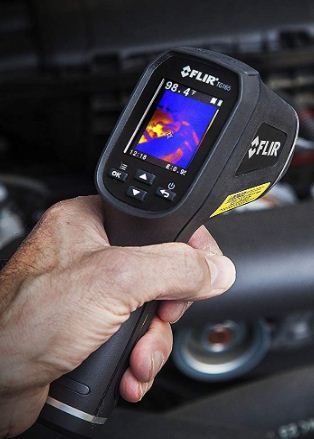
If you often deal with extreme temperatures such as inspecting refrigeration equipment or inspecting things like a car engine or boiler, get a thermal camera with a wide temperature range.
The widest range we have above is –13°F to +716°F for the FLIR TG165.
For more basic applications like home repairs,most cheap thermal cameras will have an adequate temperature range.
Visual and Thermal Image Overlay
An increasing number of budget thermal imagers now come with two cameras: a normal visual camera like the one on your phone and a thermal camera. This allows the imager to show a visual and thermal image.
Overlaying the two images lets you pinpoint where certain hot or cold spots are. We especially love thermal cameras like HT-19 and IR0005 that let you choose how much to blend the images.
Settings and Options
Don’t expect much in the menu. Beyond basic settings such as screen brightness and temperature units, most budget cameras only offer palette section, a couple or so measurement modes and a few emissivity presets.
Cheaper models don’t even let you adjust emissivity.
Media Recording
A budget thermal imager should offer at least image capture. Some also include video capture. Image and video recording is great if you want to save thermal media for further observations to share with other people.
Don’t forget to check if the thermal camera has storage such as an SD card, or if you have to buy your own.
Refresh Rate
Another area to keep your expectations low is the refresh rate. This refers to the number of times per second the thermal sensor records a new image.
Virtually all budget thermal imaging cameras have a slow refresh rate of about 9Hz. This causes the display to lag when you move the camera or point it at a moving target.
FAQs
What is the cheapest thermal camera?
The Seek Thermal Compact smartphone thermal camera is one of the cheapest thermal imagers that offers good thermal resolution, a wide temperature range and image/video recording.
Can I use my phone as a thermal camera?
No, you cannot. Your phone has a visual camera that cannot collect infrared radiation from the environment to show thermal images.
The best your phone can do is become a display for a smartphone-connected thermal camera like FLIR ONE and Seek Thermal Compact.
Why are thermal cameras expensive?
Thermal cameras are expensive because they use special sensors and lenses that are expensive to manufacture.